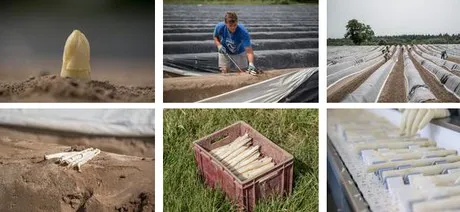Compared to last year, the asparagus season was a more mediocre, quieter season for most growers. Due to the weather, there were no surpluses and on cooler days the demand could be quite low. Overall, the price levels were low on average and production costs continued to rise. An ongoing issue has been and still is the labor shortage. Overall, the harvest will be smaller, certainly compared to the record year of 2018.
"The mood among the asparagus producers is very different. Rising production costs, moderate prices and shortages of harvest workers lead to reduction of the acreage and production. Increasing mechanization allows companies with larger and more coherent areas to absorb the rising costs, while others will reduce their acreage or are forced to cease production altogether. Bilateral agreements with Serbia, Ukraine and other Western Balkan countries can alleviate the situation. We also ask the retail trade for a fair price, which also takes into account the production costs in the producing country," said Simon Schumacher, spokesman for the Association of South German asparagus and strawberry grower e. V. (VSSE).

Evenly paced harvest
According to the Agrarmarkt Informations-Gesellschaft mbH (AMI), the phase that saw high prices for the first asparagus of 2019 was very short. The price pressure could not be explained by the weather or excess quantities. The development of labor costs and average consumer prices shows that rising labor costs are only partially reflected in consumer prices. While labor costs increased by 44 percent between 2014 and 2019, consumer prices rose by 16 percent overall, or just 3 percent, depending on the season.
"Prices were lower relatively early, earlier than the weather would suggest. The course of the harvest was more even, as extreme heat phases did not occur. At the companies in East Germany, the mood is very different. The problem formed by a lack of workers continues to increase," explains asparagus cultivation consultant Jürgen Schulze.
Labor shortage slows down harvest
"Compared to the last, this season was a good average for most growers in Lower Saxony. 2017 was too wet, 2018 was much too warm. In 2019, late frosts led to hollowed out stems and browning, but this was quickly corrected by the growers. The shortage of harvest workers, on the other hand, will remain a big topic. Overall, the harvests will be smaller," says vegetable cultivation consultant Friederike Herberg of the Chamber of Agriculture Lower Saxony.
Also, fields that suffered particularly heavily from last year's drought, that could not replenish their reservoirs over the winter, saw noticeably smaller yields. "In North Rhine-Westphalia, there were areas with very good asparagus qualities, but also farms with disastrously small quantities, which partly has something to do with the extreme drought of 2018. Very few new plants were planted this year. Also, there are more and more companies that are dropping out for a lack of successors. All in all, this season was better than last year and therefore satisfactory, even if prices were down considerably," says Carsten Wenke, Asparagus cultivation consultant for the Chamber of Agriculture of North Rhine-Westphalia.
Companies will stop production
Rising personnel costs, low prices and bottlenecks caused by shortage of harvest workers led to areas being taken out of the harvest prematurely. "The positive thing about the season was that crops and demand were usually just right, so customers always had fresh asparagus. Although there were no surpluses, the price remained low. For many growers in southern Germany it was a difficult season. Some will discontinue their production, many will consider it," asparagus cultivation consultant Dr. Ludger Aldenhoff.
A total of 1,779 asparagus farms (2017: 1,868 farms) cultivated the total of 28,379 hectares of cultivated land (including young plants) last year, which corresponds to a 5 per cent increase in acreage compared to 2017 with a simultaneous decline in cultivators of 4.7 per cent. Since 2014, according to the Federal Statistical Office, the number of companies has fallen by 11 percent.
For more information:Verband Süddeutscher Spargel- und Erdbeeranbauer e.V.
Werner-von-Siemens-Str. 2-6 / Gebäude 5161
76646 Bruchsal
Simon Schumacher Geschäftsführer / Vorstandssprecher
Tel.: +49 (0)7251 3032080
schumacher@vsse.de
Isabelle Bohnert
Referentin für Presse- und Öffentlichkeitsarbeit
Tel.: +49 (0)7251 3032184
bohnert@vsse.de
www.vsse.de
